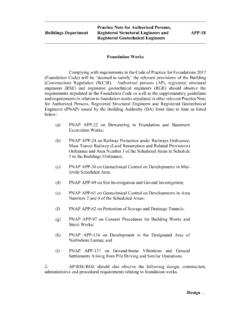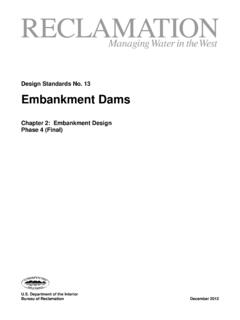Transcription of 3 PROPERTY ANALYSIS - HUD
1 3 PROPERTY ANALYSIS . 3-0 INTRODUCTION. The FHA guidelines for PROPERTY ANALYSIS include specific requirements to which appraisers must adhere for the appraisal to reflect an accurate valuation that win: o denote any deficiencies in the subject PROPERTY o protect HUD's interest in that PROPERTY The PROPERTY ANALYSIS includes General Acceptability Criteria for conducting the appraisal to address FHA minimum PROPERTY requirements. 3-1 APPRAISAL REQUIREMENTS. o The appraiser must make a complete visual inspection of the subject PROPERTY - interior and exterior - and complete the VC form.
2 O The appraiser must take photographs that show the sides, front and rear of the subject PROPERTY and all improvements on the subject PROPERTY with any contributory value. A. photograph of the street frontage is also required. o The appraiser is required to submit a single photograph of each comparable sale transaction in the addenda to the appraisal report. o The map of proposed construction must clearly show proposed roadways. o The appraiser must provide a copy of a local street map that shows the location of the PROPERTY and each comparable sale.
3 O If the subject PROPERTY is proposed construction and the improvement has not started, the appraiser should take a photograph that shows the grade of the vacant lot. 3-2 ANALYSIS OF SITE. For both proposed and existing construction, the appraiser must determine the present highest and best use for the site, disregarding improvements that may exist or are proposed for the site. This conclusion serves as the basis of comparison for estimating the market price of the land and discloses the extent to which the existing or proposed building improvements are appropriate or inappropriate for the site.
4 This also forms the basis for selecting comparable land sales. The appraiser must analyze the site to: o establish the basis for comparing the market estimates of sites in the estimate of replacement cost of the PROPERTY o determine suitability for the existing or proposed use 3-1. Carefully consider the topography, suitability of soil, off-site improvements, easements, restrictions or encroachments. A. TOPOGRAPHY. (3-2). Proper topography and site grading can be important elements in preventing wet basements, damp crawl spaces, erosion of soils, and overflowing sewage disposal systems.
5 To ensure proper protection, the appraiser must analyze the relationship of street grades, floor elevations, and lot grades. If the foundation or its bearing soils may be affected by seepage or frost, the dwelling is unacceptable unless the surface and subsurface water is diverted from the structures to ensure positive drainage away from the foundation. B. SUITABILITY OF SOIL. Consider the readily observable soil and subsoil conditions of the site including the type and permeability of the soil, the location of the water table, surface drainage conditions, compaction, rock formations and other physical features that affect the value of the site or its suitability for development.
6 Also observe the effects of the adverse features of the adjoining land. C. OFF-SITE IMPROVEMENTS. Consider the off-site improvements adjoining the subject PROPERTY , including street surface, curbs, sidewalks, curb cuts, driveways, aprons, etc., that are not contained within the legal boundaries of the site but enhance the market acceptance and the use and livability of the PROPERTY . Also consider these situations: o Compare the subject PROPERTY with the immediate neighborhood to determine the dominant off-site improvements required by the market.
7 Note any necessary off-site improvements that are not in existence or are proposed for the subject PROPERTY and adjust for them in the market value. o Any proposals for installing off-site improvements and levying assessments by the local governing body in the near future may affect value. These proposals will necessitate a commitment condition that requires the installation of improvements and the payment of the assessment before or immediately after insurance endorsement. D. EASEMENTS, RESTRICTIONS OR ENCROACHMENTS. Consider all easements, restrictions or encroachments and their impact on the market value of the subject PROPERTY and list them on the appraisal.
8 These factors are often discovered during the survey and title report once the appraisal has begun. Perform limited due diligence to verify the existence of these types of significant limiting factors. Also record these items in the URAR which were considered in the value estimate. E. ENCROACHMENTS. As a general rule, an encroachment will cause a PROPERTY to be ineligible for FHA mortgage insurance. However, there are exceptions to this rule and further information can be found by calling the lender. The appraiser should identify any of these conditions: 3-2.
9 4150. 2. o encroachment of a dwelling, garage, another physical structure or other improvement onto an adjacent PROPERTY , right-of-way or utility easement o encroachment of a dwelling, garage, another physical structure or improvements on the subject PROPERTY o encroachment of a dwelling, garage or another physical structure into the setback requirement An encroachment may be acceptable if the adjoining landowner or the local governing authority provides a perpetual encroachment easement that is filed in the County Clerk and Recorder's Office.
10 The Direct Endorsement under-writer will handle this issue under the General Waiver guidelines. 3-3 ANALYSIS OF PHYSICAL IMPROVEMENTS. ANALYSIS of the physical improvements results in conclusions as to the desirability, utility and appropriateness of the physical improvements as factors in determining mortgage risk and the ultimate estimate of value. A. GROSS LIVING AREA. Gross Living Area is the total area of finished, above-grade residential space. It is calculated by measuring the outside perimeter of the structure and includes only finished, habitable, above-grade living space.













